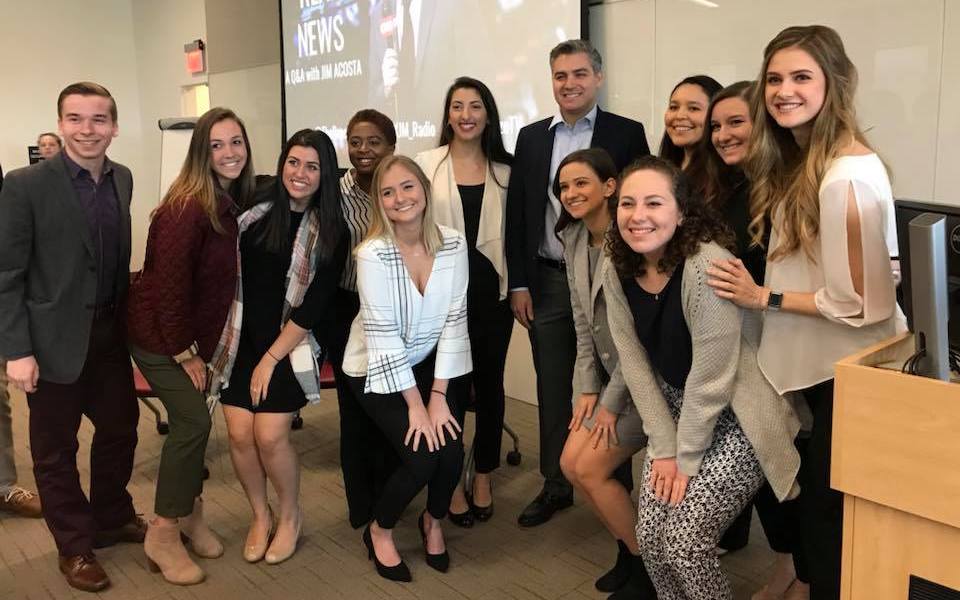JMU Alum Jim Acosta Speaks To Student Journalists
News
This story originally appeared in The Breeze and is written by Madisson Haynes & Emma Korynta. Image courtsey of Brad Jenkins.
In a time characterized by flannel shirts, Nirvana and the pre-AOL era, Jim Acosta specifically remembers being excited about the ability to send an email in Anthony-Seeger Hall. During a stint in college radio, time as an opinion columnist for The Breeze and a candidacy for SGA president, Acosta found his true passion — the media.
Years after he received his degree in mass communications (‘93), he is serving as CNN's chief White House correspondent in Washington, D.C., which became effective January 2018. In this role, Acosta has received criticism from the Trump administration, inducing being called “fake news” by President Trump.
Acosta is known for asking tough questions during press conferences. After being the first reporter to be called “fake news,” being told to “get out” of the press room and being ignored in many meetings, Acosta has continued serving the public through CNN.
“When the president of the United States refers to members of the press as the enemy of the people, the only outcome of that is to have millions and millions of people lose some faith in the press, and lose faith in journalists,” Acosta said.
Acosta is a firm believer that journalists serve to inform without taking sides. While he believes that in a democratic society, journalists have the freedom to voice the truth to the public sphere, Acosta also believes it’s not always easy.
“We’re not in a country that has a king, we’re not in a country where there’s a dictator, and we’re worried about which question we’re going to ask,” Acosta said. “He’s the president, he’s a big guy, he can take all of this stuff and he should be able to answer the question. So my attitude is well, just throw the toughest question you can.”
Acosta’s background has paved the way for his current career path. He and his family have strong ties to the immigrant population. As an 11-year-old, Acosta’s father moved to Miami and then Northern Virginia from Cuba. He didn’t speak any English and didn’t have winter clothes. Acosta believes he’s been a part of a society that celebrates being a country of immigrants, including his father.
“I call him the original dreamer because he came to this country at 11 years old — can you imagine?” Acosta said. “This is the 1960s, it ain’t the 21st century where everybody speaks a different language and there’s lots of Latino immigrants. He was one of the first Latino immigrants to really come into this country, and I call him a Cuban redneck because he’s got more of a southern Virginia accent than a Cuban.”
Roger Soenksen, a professor in the Media Arts & Design department and The Breeze's legal adviser, taught Acosta in a mass communications course. The course, which is now required for the major, was an elective when Acosta attended the university. Soenksen believes Acosta had the motivation and drive to prepare him for the future.
“You knew when you first met him that he had, I don't know how to phrase it other than the ‘it quality,” Soenksen said. “You knew that if he stayed in this particular business that he was going to go quite a distance professionally.”
According to Soenksen, everything Acosta did was of his own willpower. Soenksen takes pride in many of his students, including Acosta.
“I can't claim that anything I’ve done has helped him get into that position,” Soenksen said. “Having a student in the class and remembering that experience is a positive experience, it's something to build on. That’s why I'm in this business.”
When Acosta began at CNN in 2007, the public had more trust in the media. As of late, he’s had to deal with the concept of being called “fake news.” While working with Matthew Hoye, senior producer for the political unit at CNN, Acosta has adapted to the increased hostility from people who view the mainstream media as the “enemy of the people.”
“That sort of thing just didn’t happen in the other campaigns,” Hoye said. “People would be mad at us or come and talk to us, but it was never this like boiling anger that I saw a lot of at the Trump rallies and Trump campaigns. That’s very different, that’s changed. As far as our relationship, I think it’s made it stronger. It’s like, we’re both in this together.”
Hoye and Acosta have worked together on and off for the last six years, and have gone from partners to “best friends,” according to Hoye, who has worked with CNN for over 20 years. Their partnership allows Acosta to always be prepared for daily tasks ranging from live video reporting to getting in a question with the president at a conference.
“I wouldn’t trade this job for anything,” Hoye said. “Working with Jim is just a bonus. … I love working with him.”
While both Acosta and Hoye acknowledge that they can’t predict what’ll happen next election or even next week, they both find this uncertainty keeps the job exciting. The days are long and they have to schedule in time for themselves, but they both feel that it’s worth it.
Acosta acknowledges how far he’s come from his time at JMU and his first media job at WMAL radio in Washington, D.C., which paid $6 an hour. He feels that this is the best time to go into the field of journalism, despite all the risks.
“When you’re a journalist, you have these opportunities to be in incredible moments in history,” Acosta said. “That’s why I do it, just to be able to be on the front line of history and witness it first hand. That’s what makes it special for me.”
